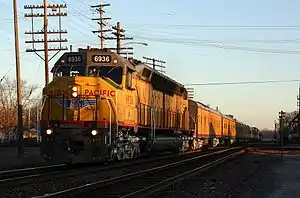EMD DDA40X
The EMD DDA40X is a 6600 hp (4943 kW) D-D locomotive, built from 1969 to 1971 exclusively for the Union Pacific. It is the most powerful diesel-electric locomotive model ever built on a single frame, having two 16-645E3A diesel prime movers.[1] Union Pacific has marked DD40X on the cab exteriors, while EMD literature inconsistently refers to this model as either DD-40X or DDA40X.[2]
| EMD DDA40X | |||||||||||||||||||||||||||||||||
|---|---|---|---|---|---|---|---|---|---|---|---|---|---|---|---|---|---|---|---|---|---|---|---|---|---|---|---|---|---|---|---|---|---|
 Union Pacific #6936 pulling a business train in Watseka, Illinois | |||||||||||||||||||||||||||||||||
| |||||||||||||||||||||||||||||||||
| |||||||||||||||||||||||||||||||||
| |||||||||||||||||||||||||||||||||
| |||||||||||||||||||||||||||||||||
Description
In 1969, Union Pacific was retiring the last of their gas turbine-electric locomotives. Union Pacific had ordered EMD DD35s and DD35As to replace the turbines, and the DDA40X was a further development.
The first DDA40X, UP#6900, was delivered in April 1969, in time to participate in the celebrations of the centennial anniversary of the completion of the First Transcontinental Railroad driving the "Gold Spike Limited"; it arrived in Salt Lake City, Utah, on the morning of May 10, 1969. Forty-six more were built between June 1969 and September 1971, numbered from 6901 to 6946.
The DDA40X is 98 ft (30 m) long. The frames were fabricated by the John Mohr Company of Chicago, because they were too large for EMD's factory. The use of more than one prime mover in a single locomotive was not new; the E-series were popular dual-engine locomotives, and Baldwin had produced (but not sold) a locomotive with four diesel engines.
The "X" in the model number stood for experimental, as DDA40X Centennials were testbeds for technology that would go into future EMD products. UP frequently used these locomotives to haul heavy freights. Each unit successfully ran some 2 million miles (3.2 million kilometers) before they were retired from revenue service in 1985. The modular electronic control systems later used in EMD Dash-2 models were first used on the DDA40X and the 4200 HP SD45X. All DDA40X units included a new load test circuit, whose dynamic braking resistors allowed units to load test without a track-side load test box.
The DDA40X has a wide nose akin to those on the F45 and FP45 cowl units. These cabs were superficially similar to the Canadian comfort cab introduced by Canadian National in 1973, though without the structural reinforcements of the Canadian design.[3]
Other experiments were conducted during the service life of these locomotives. A few of the units were fitted with Federal Signal Thunderbolt air raid sirens to warn track-side personnel when away from grade crossings, but the results were inconclusive. Another of the tests included modular electrical components, which was successful. This made for easier diagnosis of electrical problems. These modifications were used in all future locomotives built by EMD. Gearing was 59:18, allowing 80 mph on freight trains.
Despite their excellent performance and relatively good efficiency, these units were costly to maintain which ultimately prompted the Union Pacific to begin retiring them in 1984. All were retired by 1986. Eleven DDA40X units are preserved by various museums, while another unit survives as a source of spare parts for other locomotives. UP 6936, the sole operating unit, is owned by the Union Pacific and is used in excursion service.
Surviving examples
Thirteen DDA40Xs survive today, including No. 6936, which is still in service with Union Pacific:
- 6900 - Kenefick Park, Omaha, Nebraska. The first DDA40X built, it is situated next to Big Boy locomotive 4023.
- 6901 - Ross Park, Pocatello, Idaho.
- 6911 - Mexico Museum of Technology, Mexico City.
- 6913 - Museum of the American Railroad, Frisco, Texas.
- 6915 - Southern California Chapter, Railway and Locomotive Historical Society, Fairplex, Pomona, California.
- 6916 - Utah State Railroad Museum, Ogden, Utah.
- 6922 - Cody Park, North Platte, Nebraska.
- 6925 - Stored at Dakota Southern Railway’s rail yard located in Chamberlain, South Dakota.
- 6930 - Illinois Railway Museum, Union, Illinois. Can be used as a control cab only; engines and motors are currently non-operational.
- 6936 - In service with Union Pacific Heritage Fleet.
- 6938 - North Little Rock, Arkansas. Sits in front of Jenks Locomotive Facility.
- 6944 - Museum of Transportation, St. Louis, Missouri. No. 6944 was sent to Altoona in July 2014 for cosmetic restoration, which was completed in May 2015. The locomotive returned to St. Louis in June 2015.
- 6946 - Western Pacific Railroad Museum, Portola, California. The last DDA40X built, it is fairly complete and on static display.
References
- Solomon, Brian, 1966- (15 June 2016). "EMD DDA40X". The field guide to trains : locomotives and rolling stock. Minneapolis, Minnesota. p. 189. ISBN 9780760349977. OCLC 928614280.CS1 maint: multiple names: authors list (link)
- https://www.up.com/aboutup/special_trains/diesel-electric/index.htm
- CN Locomotive Cab Layout GR-20c, Commission of Inquiry Hinton Train Collision, December 1986
- Union Pacific Railroad Locomotive Department (1979). Locomotive Diagram Book. Union Pacific Railroad Company.
- Union Pacific Railroad Locomotive Department (1994). Locomotive Diagram Book. Union Pacific Railroad Company.
- Hayden, Bob (Ed.) (1980). Model Railroader Cyclopedia-Volume 2: Diesel Locomotives. Kalmbach Books. ISBN 0-89024-547-9.CS1 maint: extra text: authors list (link)
External links
| Wikimedia Commons has media related to EMD DDA40X locomotives. |